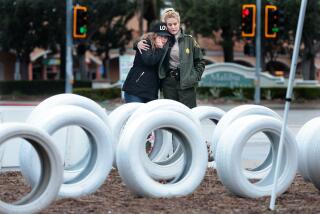California’s history of highway innovation
- Share via
If the car is king in California, then the state’s vast highway system is its realm. Millions are spent each year on improvements, such as adding carpool lanes and shoring up bridges to withstand earthquakes. A recent innovation is numbered exit signs, which the federal government called for nationwide in 1971. California is the last state to comply.
History of California’s highways
For the record:
12:00 a.m. April 14, 2005 For The Record
Los Angeles Times Thursday April 14, 2005 Home Edition Main News Part A Page 2 National Desk 1 inches; 56 words Type of Material: Correction
Lincoln Highway -- A graphic in Wednesday’s California section about the history of highways said the Lincoln Highway opened in 1913. It was in 1913 that a group of supporters formed the Lincoln Highway Assn. to guide creation of the transcontinental highway, mostly from existing stretches of roads. Segments of the highway opened at different times.
1769
El Camino Real becomes Spanish Colonial California’s first road, linking Catholic missions from San Diego to San Francisco.
1895-96
Three state Bureau of Highways officials visit every county. Their report lays the foundation for today’s freeway network. The Lake Tahoe Wagon Road becomes the first state highway.
1913
The hard-surfaced Lincoln Highway opens, linking the east and west coasts.
1926
By the time federal highway numbering is ordered, the California auto clubs
have pioneered posting of signs. They post federal and, later, state road signs over the next 20 years.
1936
The San Francisco-Oakland Bay Bridge opens during the Great Depression. It is followed a year later by the Golden Gate Bridge.
1940
The six-mile Arroyo Seco Parkway becomes California’s first freeway, a divided highway with limited access. It is now the Pasadena Freeway.
1946
Bobby Troup writes a song urging people to “get your kicks on Route 66,” a New Deal road between Chicago and Los Angeles. Route 66 is also “The Mother Road” in Steinbeck’s “The Grapes of Wrath” and a popular 1960-64 TV series.
1971
Sylmar earthquake damage prompts Caltrans to implement new bridge design criteria and begin a seismic safety retrofitting program for thousands of bridges.
1970s
Carpool lanes are introduced to relieve congestion and pollution.
2002
California announces a plan to install more than 23,000 numbered exit signs on 92 routes in the state by early 2008. (As of March 1, only 2,727 signs had been posted.)
--
New exit signs
Motorists can use the numbered exits to determine their direction of travel on freeways. Sign numbers increase from south to north and from west to east.
Mileage
The number measures how many miles that exit is from the beginning of the route.
--
Some things to watch
When the system is completed, each ramp will have as many as three numbered signs. But the center divider and carpool lanes will not have exit-number signs.
Confusing numbers
Sometimes the exit number is the same as the freeway number. On a portion of the Garden Grove Freeway, drivers encounter Exit 22, which is the same number as the state highway.
Letters follow numbers
Multiple exits within a short distance will have numbers and letters. The exit letters also ascend from south to north and from west to east.
Pesky details
* Drivers need to pass at least two exits to determine in which direction they are headed, and it helps if they have a general idea of where the freeway starts in relation to their location.
* Exits at the junction of two freeways may not be numbered. Don’t look for a number on the Pico Blvd. ramp between the I-110 and I-10, or the Wardlow Road ramp between the I-710 and the 405.
--
Sources: Caltrans, www.lincolnhighwayassoc.org, www.visit-eldorado.com, www.national66.com, www.cahighways.org, Tahoe National Forest, Historic Photos and Maps of California Highways, ESRI. Graphics reporting by Cheryl Brownstein-Santiago, Paul Duginski and Ross Toro Los Angeles Times
More to Read
Sign up for Essential California
The most important California stories and recommendations in your inbox every morning.
You may occasionally receive promotional content from the Los Angeles Times.










